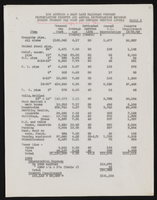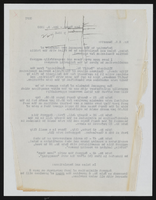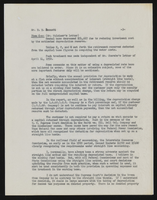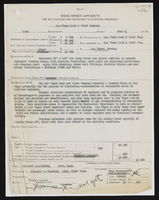Search the Special Collections and Archives Portal
Search Results
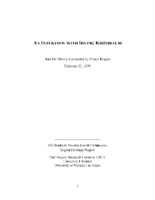
Transcript of interview with Irving Kirshbaum by Cheryl Rogers, February 23, 1979
Date
Archival Collection
Description
Interview with Irving Kirshbaum by Cheryl Rogers on February 23, 1979. In this interview, Kirshbaum discusses the Riviera Hotel where he began working in 1955. He also talks about the landscape of the Las Vegas Strip in the 1950s, and the state of gambling, comps, customer service, and dealer training. The interviewer asks about the treatment of minorities at the Riviera, and in Las Vegas generally, and the effect of corporate ownership on casinos.
Text
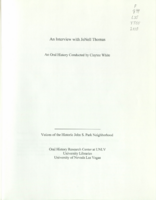
Transcript of interview with JoNell Thomas by Claytee White, January 12, 2010
Date
Archival Collection
Description
JoNell Thomas grew up in a large Utah family, went to Utah State and law school at University of Utah. She moved to Nevada in 1992; first as with the Nevada Supreme Court and then as a staff attorney with a Las Vegas firm, and currently is an attorney with the Clark County Special Public Defender's office. She and her husband, Billy Logan and their twin daughters have lived in the John S. Park Neighborhood since 2001. Their residence was constructed in 1956 on a large corner lot with lots of trees and a fifty-year-old swimming pool. JoNell offers her observations on a variety of JSP events: Stratosphere's failed rollercoaster across the Strip idea; the proposed high-rise complexes; the Monorail lack of convenience to locals; effects of dropping home prices and downturn of economy; the homeless population and closing of Circle Park. She helped create the early online community called the Downtown Neighbors website which provided information regarding , part activist, part pra
Text
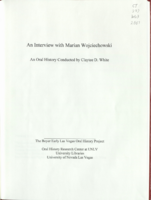
Transcript of interview with Marian Wojciechowski by Claytee White, June 16, 2009
Date
Archival Collection
Description
At age 95, Marian Wojciechowski recalls his personal story of being born a region called called Poland in 1914, just as World War I was beginning. This narrative gives special attention to his Polish background at a time when the country did not technically exist, and their language was forbidden. By the late 1930s and the dawning of World War II, Marian is a young man struggling to understand what is transpiring, but knowing that he must participate in the Polish underground resistance against the Germans His activism gets him arrested and sentenced to Auschwitz as a non-Jew and without penalty of death. He recalls the Gestapo beatings which have left him without feeling in his fingers and a loss of hearing. He shares historical perspectives of the war era, agricultural coops, goal of Germans to sell Jews to the United States and other countries, and a story about a woman who helped save 2500 Jewish children during war.
Text
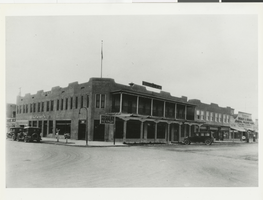
Photograph of the front exterior of the Hotel Nevada (Las Vegas), circa 1910
Date
Archival Collection
Description
Hotel Nevada after the addition of a balcony. Transcribed from photo sleeve: "by Florence Lee Jones ... March, 1969. Early Las Vegas History. The Hotel Nevada, at the Southeast corner of Main and Fremont Streets, is the oldest continuous hotel business in Las Vegas, although it has been known as Sal Sagev (Las Vegas spelled backward) since 1928. The hostelry started as a tent in 1905, but the late John Miller soon erected a permanent building, shown above, which provided the most luxurious accommodations and the best food in Las Vegas for many years. In the 1930's the Sal Sagev Hotel had one of the three elevators in town. A private dining room was a popular place for private parties for the elite of the town. The hotel is now owned and operated by Miller's son, Abe Miller, and his daughter, Mrs. Sherman E. Nugent. The Golden Gate Club now occupies much of the first floor of the building. On the North side of the building is a sign "Bank of Southern Nevada", which was the second bank established in Las Vegas. (The other was the First State Bank.) Started by John F. Miller, Ed Von Tobel, Sr., Will Beckley, Attorney Frank Stevens, and Hal D. Buzick, the Bank of Southern Nevada was an important factor in Southern Nevada's economy. During the 1930's and the Depression, the federal government issued restrictive orders on bank operations. The reaction of the independent Las Vegans was 'No guy in Washington is going to tell us how to run our bank.' ... So they paid off all the depositors and closed the bank. The Rhoads & Rhoads General Machine Works (extreme right) was one of the first automobile agencies in town - the start of Community Chevrolet."
Site Name: Hotel Nevada
Address: 1 Fremont Street
Image
George Knox Roth Collection
Identifier
Abstract
The George Knox Roth Collection (1959-1980) consists of newspaper clippings (including photocopies), magazine articles, newsletters, technical reports and publications, correspondence, notes, and photographs relating to the Atomic Energy Commission, the environmental impact of nuclear testing in Nevada, Nevada mining, Airwest and the Hughes Airport, and other aspects of Howard Hughes’ Nevada operations. The George Knox Roth Collection also includes correspondence and expense reports related to his own company, General Research Consultants.
Archival Collection

